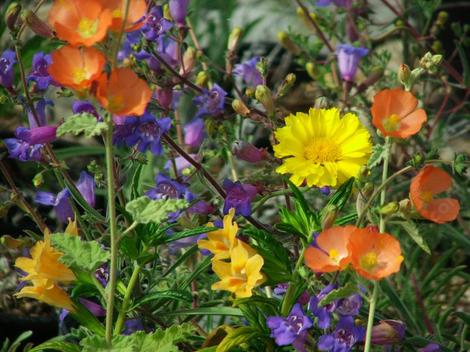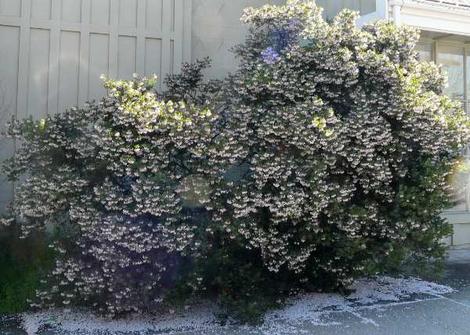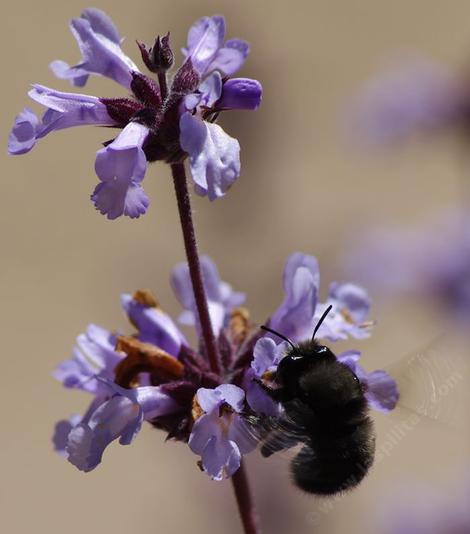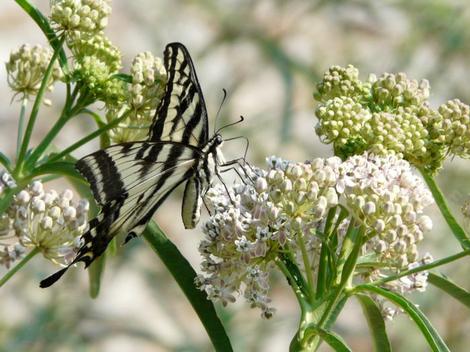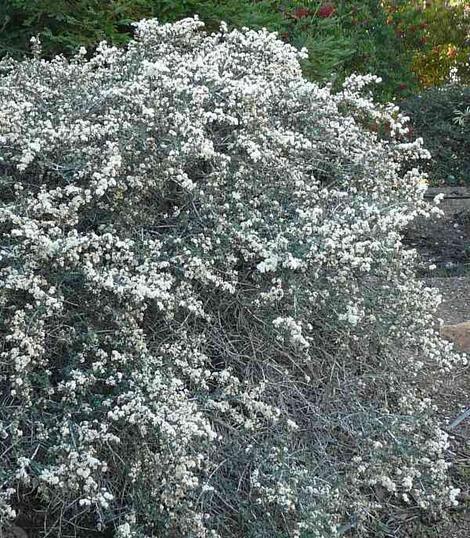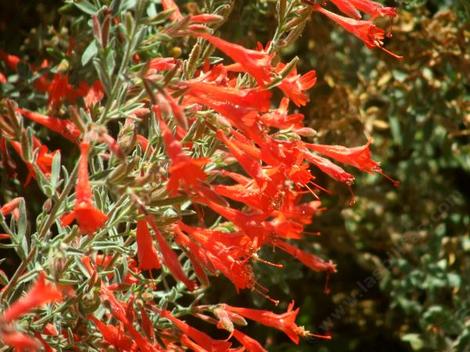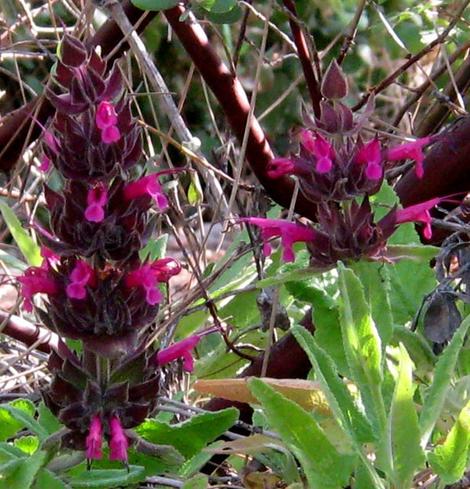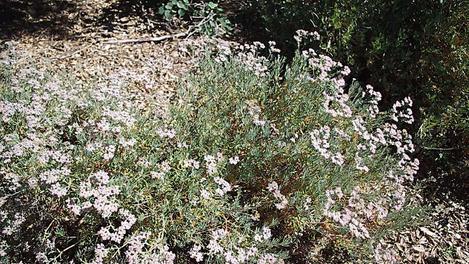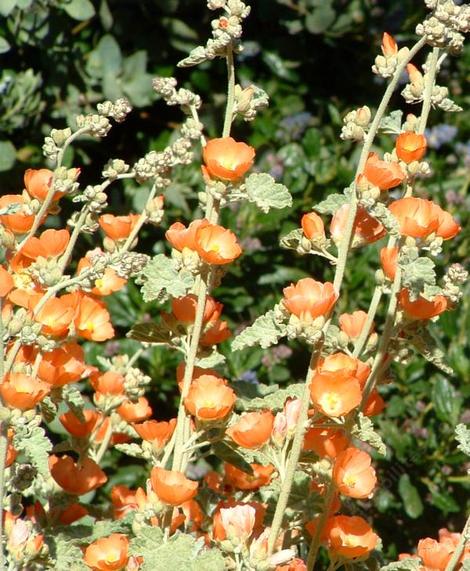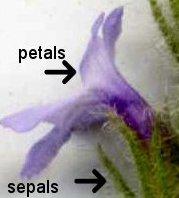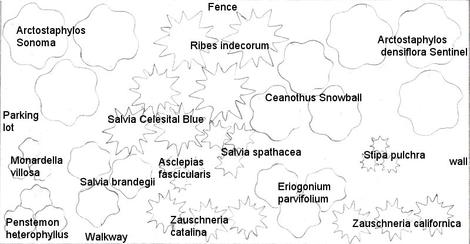How to Make a School Garden with California Native Plants
Some native plants can survive a summer with
no water. Other native plants have most of their flowers when school is
in session. Combining this diversity that you can have
class room activities with native plants and
kids for much of the school year. The plants listed below are as
non-toxic as possible and fairly easy to keep
alive.
From the planning, through planting, growing and studying should be done with the class. Make it an exercise like PE. Measure out the dimensions of the area to be a native garden. Calculate the sq. ft. make sure there is some water source, at least a faucet. discuss all this with the class. Show the class how to plant the garden using the sq. ft. per plant listed below. A simple table adding the subtotal sq. ft. for each group of plants should be something the kids can understand as soon as they can multiply.(see examples and bottom of page)
Put the larger plants at the back, or if there is not back in the middle. For less money use the larger sq. ft. plants, bigger area, use more plants.
If you do not have any money, there are some grants out there for school gardens. If that doesn't work, walk the kids over to a section of garden at the school and pretend to replace it. You can do all the activities, pretending to replace the garden and make it into a proposal for the grants.
Arctostaphylos Sonoma Manzanita Bush Stanford Manzanita 10 sq. ft. 2 ft. tall
Artemisia californica California Sagebrush 10 sq. ft. 2 ft. tall
Asclepias fascicularis Narrow leaf Milkweed 3 sq. ft. 2 ft. tall
Ceanothus Snowball 10 sq. ft. 3 ft. tall
Eriogonum parvifolium Cliff Buckwheat 4 sq. ft. 1 ft. tall
Monardella villosa Coyote Mint 1 sq. ft. 1 ft. tall
Penstemon heterophyllus; Foothill Penstemon; 1 sq. ft. 1-2 ft tall
Ribes indecorum White Chaparral Currant 20 sq. ft 5 ft. tall
Salvia brandegei Brandegees Sage 8 sq. ft. 2 ft. tall
Salvia Celestial Blue Purple Sage 6 sq. ft. 3 ft. tall
Salvia spathacea Hummingbird sage 6 sq. ft.(and spreading)1 ft.tall
Stipa pulchra Purple Needle Grass 1 sq. ft. 1ft. tall
Zauschneria californica(any cultivar) Hummingbird Fuchsia 2 sq. feet 1 ft. tall
San Joaquin and Southern California Garden (not hardy below
20F)
Arctostaphylos
pungens
Mexican Manzanita 20 sq. ft. 5 ft. tall
Asclepias fascicularis Narrowleaf Milkweed 3 sq. ft. 2 ft. tall
Ceanothus oliganthus Hairy-Leaf Ceanothus 20 sq. ft. 5 ft. tall
Eriogonum arborescens Santa Cruz Island Buckwheat 10 sq. ft. 3 ft. tall
Eriogonum fasciculatum California Buckwheat 10 sq. ft. 3 ft. tall
Penstemon spectabilis Showy Penstemon 4 sq. ft. 4 ft. tall
Salvia brandegii Island Black Sage 8 sq. ft. 2 ft. tall
Salvia clevelandii Cleveland Sage 10 sq. ft. 3 ft. tall
Salvia munzii San Diego Sage 8 sq. ft. 2 ft. tall
Sphaeralcea ambigua Desert Mallow 4 sq. ft. 2 ft. tall
Stipa pulchra Purple Needle Grass 1 sq. ft. 1 ft. tall
Zauschneria cana Narrow leaf hummingbird fuchsia 2 sq. ft. 1-2 ft. tall
Zauschneria catalina Island hummingbird fuchsia 2 sq. ft. 2 ft. tall.
Make a simple flower key. (you really only need a few different flowers for it to become difficult)
Find an insect on a plant.
Press flowers. Show them how to make a simple plant press.
What insect uses which flower and why (hummingbird, bee, butterfly)
What butterfly larva uses what plant?
Calculate how much water is given the garden and covert that to rainfall. Compare to lawn.
Quizzes
Why are the scientific names in italic? What is the difference between scientific names and common names? How are scientific names created?
From the planning, through planting, growing and studying should be done with the class. Make it an exercise like PE. Measure out the dimensions of the area to be a native garden. Calculate the sq. ft. make sure there is some water source, at least a faucet. discuss all this with the class. Show the class how to plant the garden using the sq. ft. per plant listed below. A simple table adding the subtotal sq. ft. for each group of plants should be something the kids can understand as soon as they can multiply.(see examples and bottom of page)
Put the larger plants at the back, or if there is not back in the middle. For less money use the larger sq. ft. plants, bigger area, use more plants.
If you do not have any money, there are some grants out there for school gardens. If that doesn't work, walk the kids over to a section of garden at the school and pretend to replace it. You can do all the activities, pretending to replace the garden and make it into a proposal for the grants.
Northern California Garden (north of San Luis Obispo)
Arctostaphylos densiflora Sentinel Manzanita Sentinel Manzanita 10 sq. feet 3 foot tallArctostaphylos Sonoma Manzanita Bush Stanford Manzanita 10 sq. ft. 2 ft. tall
Artemisia californica California Sagebrush 10 sq. ft. 2 ft. tall
Asclepias fascicularis Narrow leaf Milkweed 3 sq. ft. 2 ft. tall
Ceanothus Snowball 10 sq. ft. 3 ft. tall
Eriogonum parvifolium Cliff Buckwheat 4 sq. ft. 1 ft. tall
Monardella villosa Coyote Mint 1 sq. ft. 1 ft. tall
Penstemon heterophyllus; Foothill Penstemon; 1 sq. ft. 1-2 ft tall
Ribes indecorum White Chaparral Currant 20 sq. ft 5 ft. tall
Salvia brandegei Brandegees Sage 8 sq. ft. 2 ft. tall
Salvia Celestial Blue Purple Sage 6 sq. ft. 3 ft. tall
Salvia spathacea Hummingbird sage 6 sq. ft.(and spreading)1 ft.tall
Stipa pulchra Purple Needle Grass 1 sq. ft. 1ft. tall
Zauschneria californica(any cultivar) Hummingbird Fuchsia 2 sq. feet 1 ft. tall
San Joaquin and Southern California Garden (not hardy below
20F)
Arctostaphylos
pungens
Mexican Manzanita 20 sq. ft. 5 ft. tallAsclepias fascicularis Narrowleaf Milkweed 3 sq. ft. 2 ft. tall
Ceanothus oliganthus Hairy-Leaf Ceanothus 20 sq. ft. 5 ft. tall
Eriogonum arborescens Santa Cruz Island Buckwheat 10 sq. ft. 3 ft. tall
Eriogonum fasciculatum California Buckwheat 10 sq. ft. 3 ft. tall
Penstemon spectabilis Showy Penstemon 4 sq. ft. 4 ft. tall
Salvia brandegii Island Black Sage 8 sq. ft. 2 ft. tall
Salvia clevelandii Cleveland Sage 10 sq. ft. 3 ft. tall
Salvia munzii San Diego Sage 8 sq. ft. 2 ft. tall
Sphaeralcea ambigua Desert Mallow 4 sq. ft. 2 ft. tall
Stipa pulchra Purple Needle Grass 1 sq. ft. 1 ft. tall
Zauschneria cana Narrow leaf hummingbird fuchsia 2 sq. ft. 1-2 ft. tall
Zauschneria catalina Island hummingbird fuchsia 2 sq. ft. 2 ft. tall.
Example 1. Native garden for Northern California |
quantity |
sq. ft. each |
subtotal sq. ft. |
price each |
price subtotal |
| Arctostaphylos densiflora Sentinel | 3 |
10 |
30 |
8 |
24 |
| Arctostaphylos Sonoma Manzanita |
3 |
10 |
30 |
8 |
24 |
| Asclepias fascicularis | 3 |
2 |
6 |
8 |
24 |
| Ceanothus Snowball |
3 |
10 |
30 |
8 |
24 |
| Eriogonium parvifolium | 3 |
10 |
30 |
8 |
24 |
| Monardella villosa |
3 |
1 |
3 |
8 |
24 |
| Penstemon heterophyllus |
3 |
1 |
3 |
8 |
24 |
| Ribes indecorum | 3 |
8 |
24 |
8 |
24 |
| Salvia brandegii | 3 |
8 |
24 |
8 |
24 |
| Salvia Celesital Blue | 3 |
6 |
18 |
8 |
24 |
| Salvia spathacea |
3 |
6 |
18 |
8 |
24 |
| Stipa pulchra |
3 |
1 |
3 |
8 |
24 |
| Zauschneria californica | 3 |
2 |
6 |
8 |
24 |
| Zauschneria catalina | 3 |
2 |
6 |
8 |
24 |
| 231 sq. ft. |
$336 |
Example 2. Native Garden for Southern California |
quantity |
sq. ft. each |
subtotal sq. ft. |
price each |
price subtotal |
| Arctostaphylos pungens |
1 |
20 |
20 |
8 |
8 |
| Asclepias fascicularis | 3 |
2 |
6 |
8 |
24 |
| Ceanothus oliganthus |
1 |
20 |
20 |
8 |
8 |
| Eriogonium arborescens |
3 |
10 |
30 |
8 |
24 |
| Eriogonum fasculatum | 3 |
10 |
30 |
8 |
24 |
| Penstemon spectablis | 3 |
4 |
12 |
8 |
24 |
| Salvia brandegii | 3 |
8 |
24 |
8 |
24 |
| Salvia clevelandii | 3 |
10 |
30 |
8 |
24 |
| Salvia munzesi |
3 |
8 |
24 |
8 |
24 |
| Sphaeralcea ambigua | 3 |
4 |
12 |
8 |
24 |
| Stipa pulchra |
5 |
1 |
5 |
8 |
40 |
| Zauschneria cana |
3 |
2 |
6 |
8 |
24 |
| Zauschneria catalina | 3 |
2 |
6 |
8 |
24 |
| 225 sq. ft. |
$296 |
Ideas for class activities
Weed and plantMake a simple flower key. (you really only need a few different flowers for it to become difficult)
Find an insect on a plant.
Press flowers. Show them how to make a simple plant press.
What insect uses which flower and why (hummingbird, bee, butterfly)
What butterfly larva uses what plant?
Calculate how much water is given the garden and covert that to rainfall. Compare to lawn.
Quizzes
Why are the scientific names in italic? What is the difference between scientific names and common names? How are scientific names created?
